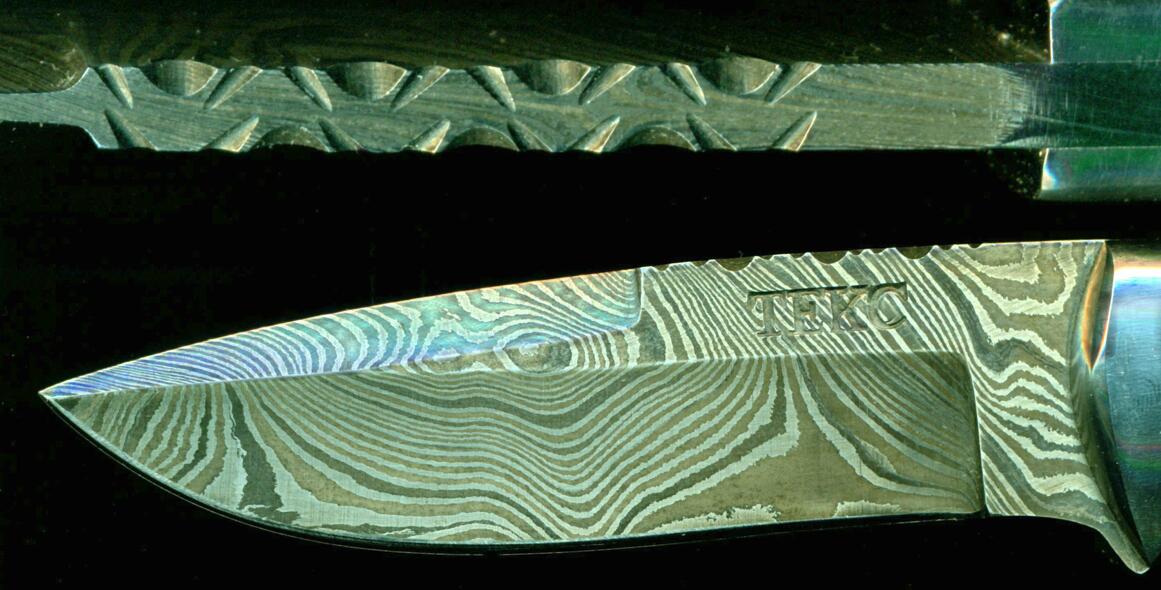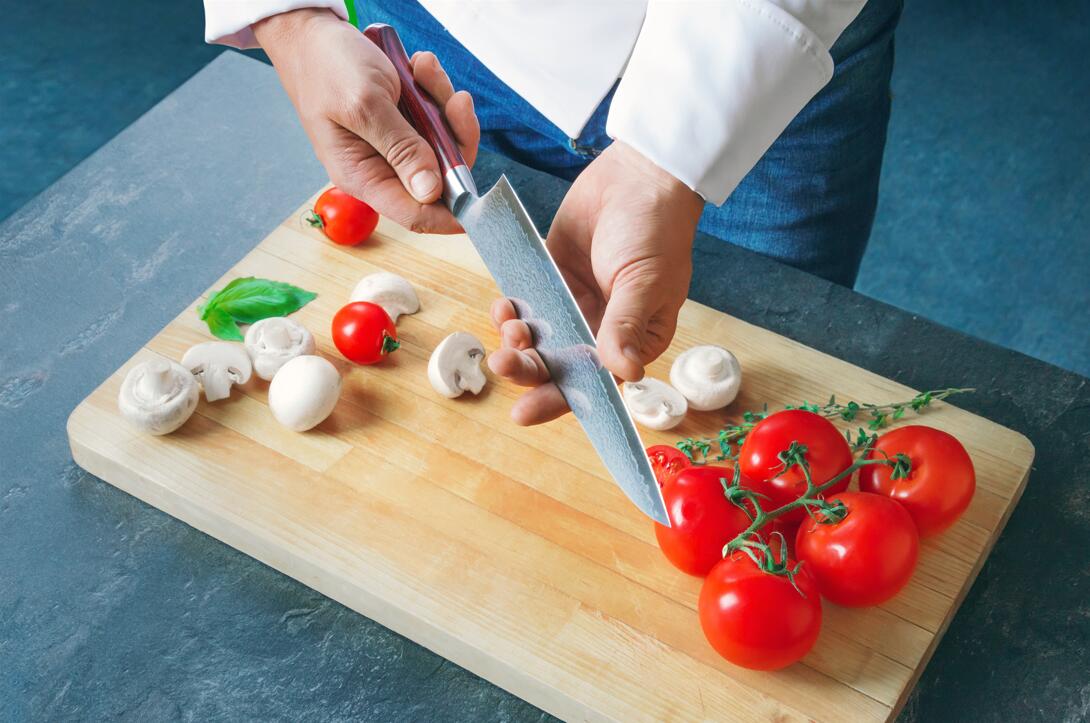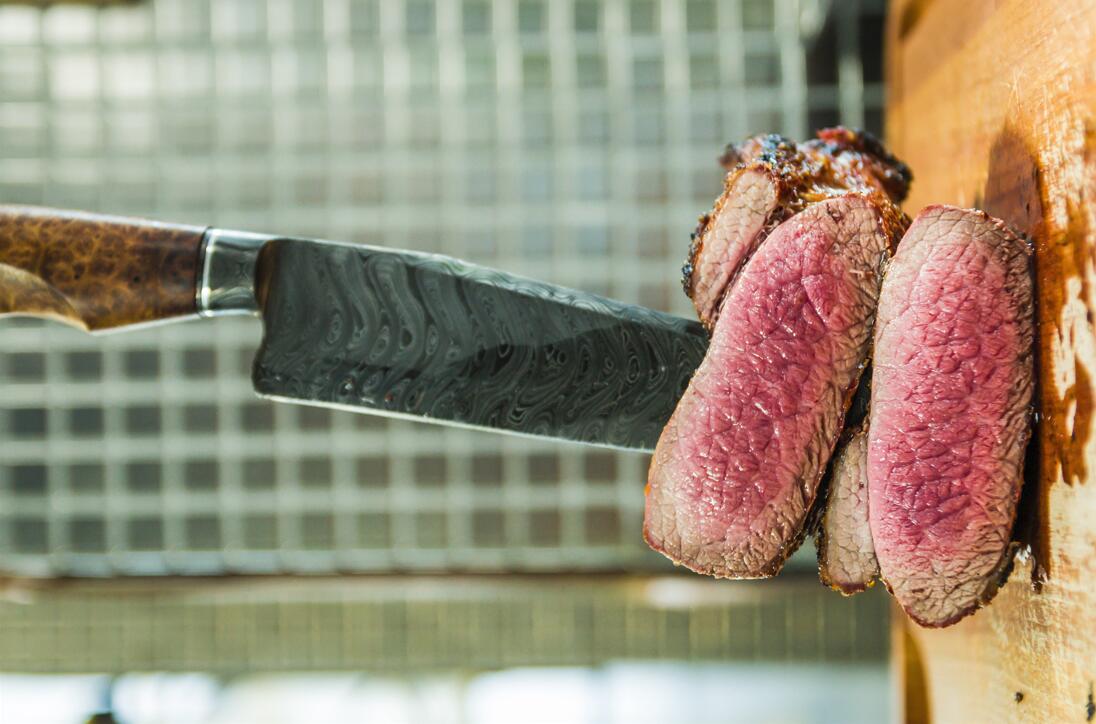Damascus steel knives have been prized for their beauty and visual appeal. These kitchen knives have gained extreme popularity in recent years. The chances are you already have one in your set of knives or planning to get one.
The beautifully crafted Damascus patterns on a kitchen knife are enough to get anyone’s attention. It almost seems like every Damascus steel knife is different. The unique patterns give each knife a special characteristic.
Before we can dive right into these different patterns found in Damascus steel knives, we have a lot to cover. In this article, we’ll go over everything you need to know about Damascus steel knives and their gorgeously composed patterns.
Table of contents
What is Damascus steel?

Damascus steel we use today and what it was once is somewhat different. In the past, Damascus steel was made from a type of steel called wootz. In the 1700s, when gun production ramped up, the methods of making wootz steel were lost. This also took away the original technique of producing Damascus steel with it.
This loss didn’t stop knife makers and scientists from recreating the original Damascus steel. Scientists have recreated the original Damascus steel through dedicated experiments. However, the term “Damascus” we are using today can refer to another type of steel: pattern welded steel.
Traditional Damascus steel
Not much is known about how the traditional Damascus steel came into existence in the first place or its production methods. What we know, however, is it was initially made from a type of steel from India, wootz, a crucible steel that’s made following certain procedures.
The reproduction of this steel exists, but is not as popular as modern pattern-welded Damascus steel.
Modern Damascus steel
In modern-day knife-making, Damascus steel is referred to as pattern-welded steel. Modern Damascus steel is produced by mixing two or more different types of steel in the forge, known as pattern-welding. Take two different steel billets, stack the two together or weld them, put them in the forge, and fold continuously to mix everything. The end result of this is Damascus steel.
Doing these will technically give you what we now call Damascus steel, but it isn’t the same as the original. Nevertheless, the modern Damascus steel is just as strong, hard, yet flexible enough to uphold resistance.
While this is how modern Damascus steel is made, the patterns don’t just occur. Mixing two or more types of steel and combining them to make one steel block doesn’t give us the patterns we’re anticipating – at least make them as apparent as we want. The process of annealing and acid etching is what reveals the patterns which come after heat-treating and some grinding.
The etching refers to the process of submerging the annealed blade into acid, like ferric chloride. The steel’s response to the acids reveals the patterns as different steels react differently, forming a distinctive design. Although this doesn’t give us the authentic, original Damascus steel, the outcome is just as beautiful.
Damascus patterns

There isn’t a single pattern found in Damascus steel knives. Everything from the types of steel used to how folding, welding, etching, and other chemicals are utilized alters the pattern uniquely.
How are Damascus patterns formed?
Damascus patterns are formed by combining different types of steel to create a single steel block. When forge-welded, the patterns appear. Generally, two opposing types of steel are combined, like carbon steel and stainless steel. These two types of steel have different appearances where carbon steel is darker in color, and stainless steel is shiny.
Since mixing different pieces of steel isn’t like blending fluids, they don’t entirely merge. Certain techniques like pressing, folding, and twisting help bring two together and form these patterns, creating unique designs once the steel is cooled and grounded. Lastly, acid etching makes these patterns clear by giving a distinct finish.
Importance of pattern-welding
The pattern-welding is just as functional as it is required for creating the patterns. It can bring out the best of two different types of steel: hard and soft.
By nature, hard steel is excellent at holding an edge. At the same time, it’s just as fragile and prone to chip or even shattering. On the other hand, soft steel can resist damage, but edge retention is a problem, requiring the user to sharpen and hone more often.
When these two different steel is fused following pattern-welding, you get the best out of two worlds. The result is a knife that holds an edge well but is also strong enough to resist chipping. This is one of the reasons why Damascus steel knives are a favorite choice for both home and professional cooks.
Types of Damascus steel patterns

There are many different Damascus steel patterns. It isn’t all that hard to create a distinct design. The types of steel used, the etching process, and the chemicals used give us something unique. However, specific types of patterns are commonly seen in Damascus steel. These are as follows.
Ladder Damascus
The ladder Damascus patterns result from pressing and grinding across a piece of Damascus steel, often a bar. The grooves are then ground flat, removing the excess high points. The steel is then forged again to shape into a blade, giving a unique ladder pattern. This is one of the most basic Damascus patterns that are relatively easier to make.
Raindrop Damascus
Similar to the ladder pattern, the raindrop Damascus pattern is created by pressing. However, in a much more concentrated area by creating dimples this time. Like the ladder pattern, the excess is ground, and the steel is reheated in the forge to shape the blade.
These two are some of the most basic Damascus patterns that even beginner blacksmiths can accomplish on the first try. Here are some of the other patterns that require more experience from the blacksmith.
Feathered Damascus
Also known as the “W” design, the feather Damascus steel is perhaps one of the most popular patterns. This pattern is created by welding multiple steel billets together to form a single one.
Around ten steel billets with two or more different types of steel are heated, hammered, and cooled continuously to form a single block. Once it’s a single steel block, it’s cut in half, and the pieces are welded together on their side. Then, put back in the forge to heat and stretched to make a blade. The result of this is a feathered Damascus pattern. The process of this pattern is a lot like opening up the steel block to reveal what’s inside.
Twisted Damascus
The twisted Damascus pattern follows a very simple process that produces various outcomes. The multiple layers of steel billets are heated, folded, and twisted to form a unified block. Each twist gives a star-like pattern at the center, creating a unique piece.
The twisting method is also done by heating multiple Damascus steel, twisting, and forge welding them together. This method creates a mosaic-like pattern that’s also known as Turkish twist Damascus.
Cable Damascus
As the name suggests, cable Damascus patterns are achieved by utilizing steel cables. At first, you might be tempted to think that the cable Damascus is similar to the twisted, considering the types of cables used as they are twisted already. It isn’t entirely like that, as you start with steel that’s already turned rather than twisting it while it’s blazing hot.
Achieving cable Damascus is pretty straightforward. Take multiple cuts of steel cable and weld them together to form a block. Heat it to the right temperature and continuously hammer it on all sides to merge them. The rest is the same as making any other knife. The result is a simple work of art that’s perfectly functioning as a knife. Blacksmiths get very creative with this and even make the blade and handle from the same steel cable piece, similar to Global Knives.
Spider web Damascus
The spider web Damascus pattern is similar to the twisted pattern. It’s a mosaic pattern that’s accomplished by stacking squares of solid steel and adding pure nickel or opposing steel, forging, and bringing everything into a small square bar.
This square bar is then cut into pieces, stacked together, and forge-welded. It’s then heated and shaped into a blade. The result is the spiderweb-like patterns on the steel often following a similar design across the blade.
Damascus patterns in jewelry
Kitchen knives aren’t the only place Damascus steel found a place after swords. There is a whole jewelry category, including necklaces, earrings, and bracelets made from stainless Damascus steel. The jewelry made from Damascus steel is often hypoallergenic, and the patterns are sought-after as they won’t wear off as long as hand-forged like knives.
Why do steel matter to Damascus patterns
The types of steel combined to form a single block are extremely important. Different steels can turn into different colors, creating a unique pattern when fused with contrasting steel. For example, some types of carbon steel can turn into a darker color due to the thin layer of oxidized iron on the surface as a result of heating. This, combined with stainless steel that’s naturally shiny, creates a darker blade with whitish patterns.
With that in mind, not every steel goes well together. It’s essential to pick up the suitable types of steel and use them together to make Damascus steel.
Does the Damascus pattern serve a purpose?

Don’t expect your Damascus steel knife to drop slices off quickly like Granton-edged knives or provide another functionality.
Damascus patterns are there solely for aesthetic reasons.
While there isn’t a functional attribute, it can tell a lot about a knife’s quality. A Damascus steel knife made following pattern welding is a durable knife with great edge retention.
The patterns on Damascus steel aren’t just on the surface. No matter how many times you scratch the blade, the marks will be there though they might be no longer visible to the naked eye. This brings us to differentiating fake Damascus steel knives from authentic ones.
How to spot fake Damascus steel blades?
Just by looking at the blade and other details of the knife, it’s next to impossible to recognize whether it’s an authentic or fake Damascus steel knife. Still, there are signs to look for in a real Damascus steel knife.
- Look for the consistency of the patterns. They should be literally covering every part of your knife that is steel, including the cutting edge, spine, bolster, tang, any other part of the blade. While pattern consistency is essential, not having these patterns throughout the blade doesn’t necessarily mean it’s not real.
- Some knife makers polish the patterns on certain parts of the blade. This commonly includes the spine, bolster, and tang. If you don’t see the patterns on these parts of your knife, the manufacturer may have removed them before shipping.
- There are measures you can take to be sure. Determine whether or not your Damascus steel knife is authentic by polishing an area of the blade until the pattern disappears. Then, submerge the blade in ferric chloride. If the same pattern appears again, it’s a strong indication that it’s made from real Damascus steel. If it’s a random pattern or mark, it’s a fake one.
- Price doesn’t truly determine the authenticity, but it’s something to consider. Damascus steel knives are reasonably expensive. You can expect to pay anywhere from $200 to $1,000 on a proper Damascus steel knife. If you see a bargain for under $100 or so, it’s likely that you’re not getting the real thing unless it’s from a reputable seller.
FAQs
How hard is it to make Damascus steel?
If you’ve made a knife before and have the necessary tools, you can make Damascus steel, or at least you can try. It certainly takes craftsmanship and knowledge of the steel used and the required temperature for each steel, but it’s doable. As long as you know what you’re doing and have a basic understanding of forging a knife, you can craft your own Damascus steel. The result may not be what you hoped for on the first try, but practice makes perfect! Learn more about how to make a knife.
Why is Damascus steel so expensive?
Making Damascus steel takes a lot of time and effort. Like any other time and labor-intensive product, it comes with a higher cost. Its visual appeal is the most popular reason why people get Damascus steel knives, but they also perform better than most other kitchen knives on the market. Sure, you can get a better-performing kitchen knife around the same price, but there is nothing like a beautifully crafted Damascus steel knife.
Can Damascus steel rust?
Damascus steel knives can be prone to oxidation and lead to rusting. However, this isn’t only for Damascus steel. Damascus steel has a high carbon content, so it’s more prone to oxidation. There is nothing to be afraid of, though. Basic care techniques like drying your knife after use, not washing it in the dishwasher, and applying food-grade mineral oil when storing are enough measures. Opt for a stainless steel version instead if these sound too much work for you, but note that the patterns won’t be as noticeable.
Conclusion
Damascus steel knives are valuable and are aesthetically pleasing. Although they won’t bring much to the table as far as performance is concerned, their visual appeal makes them worth it. There is something unique happening in each pattern, and with each cut you make, you’ll feel it.
Damascus steel knives are mostly handmade. If you’re a fan of hand-forged kitchen knives, make sure to check our collection to see what we have to offer.









